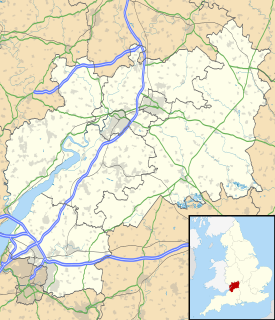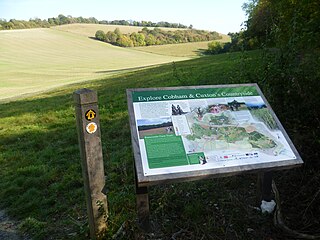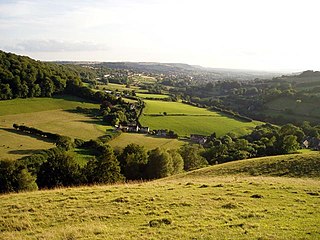
Camilla, Duchess of Cornwall, is a member of the British royal family. She received her title upon her marriage to Charles, Prince of Wales, heir apparent to the British throne, on 9 April 2005. It is a second marriage for both of them. Despite being entitled to be known as Princess of Wales, she uses the title Duchess of Cornwall, her husband's secondary designation. In Scotland, she is known as the Duchess of Rothesay.

The National Gardens Scheme opens privately owned gardens in England and Wales on selected dates for charity. It was founded in 1927 with the aim of "opening gardens of quality, character and interest to the public for charity". The scheme has raised over £60 million since it began, and now opens over 3,700 gardens a year.

The Green Park, usually known without the definite article simply as Green Park, is one of the Royal Parks of London. It is in the southern part – the core part – of the City of Westminster, Central London, but before that zone was extended to the north, to take in Marylebone and Paddington it lay in its north-centre. It is north of the gardens and the semi-circular forecourt of Buckingham Palace.

Princess Victoria of Saxe-Coburg-Saalfeld, later Duchess of Kent and Strathearn, was a German princess and the mother of Queen Victoria of the United Kingdom. As the widow of Charles, Prince of Leiningen (1763–1814), from 1814 she served as regent of the Principality during the minority of her son from her first marriage, Carl, until her second wedding in 1818 to Prince Edward, son of King George III of the United Kingdom.

Fritillaria meleagris is a Eurasian species of flowering plant in the lily family. Its common names include snake's head fritillary, snake's head, chess flower, frog-cup, guinea-hen flower, guinea flower, leper lily, Lazarus bell, chequered lily, chequered daffodil, drooping tulip or, in northern Europe, simply fritillary. The plant is native to the flood river plains of Europe where it grows in abundance.

A wildflower is a flower that grows in the wild, meaning it was not intentionally seeded or planted. The term implies that the plant probably is neither a hybrid nor a selected cultivar that is in any way different from the way it appears in the wild as a native plant, even if it is growing where it would not naturally. The term can refer to the flowering plant as a whole, even when not in bloom, and not just the flower.

The Cotswold Water Park is the United Kingdom's largest marl lake system, straddling the Wiltshire–Gloucestershire border, northwest of Cricklade and south of Cirencester. The lakes were created in the second half of the 20th century by extraction of glacial Jurassic limestone gravel, which had eroded from the Cotswold Hills, and these filled naturally after working began to cease in the early 1970s.

Cephalanthera rubra, known as red helleborine, is an orchid found in Europe, North Africa and southwest Asia. Although reasonably common in parts of its range, this Cephalanthera has always been one of the rarest orchids in Britain.
Jane Smart is a charity chief executive. She is the Global Director of the International Union for Conservation of Nature and Natural Resources (IUCN)'s Biodiversity Conservation Group and Head of its Species Program. The Biodiversity Conservation Group comprises the Species Programme, Protected Areas Programme, Global Marine Programme as well as the Invasive Species Initiative. As Head of the Species Programme Jane is responsible for around 35 staff based in Switzerland, Washington DC, US and Cambridge, UK and is responsible for managing the compilation and production of The IUCN Red List of Threatened Species™.

Cardamine pratensis, the cuckoo flower, lady's smock, mayflower, or milkmaids, is a flowering plant in the family Brassicaceae, native throughout most of Europe and Western Asia. The specific name pratensis is Latin for "meadow".

Plantlife is a wild plant conservation charity. As of 2017, it owns 23 nature reserves around the United Kingdom.
Founded in 1967, Earth Trust, is an environmental learning charity which was originally known as the Northmoor Trust for Countryside Conservation. Earth Trust was established by the British engineer Sir Martin Wood to promote environmental conservation through land management, education, and land science. It is a registered charity under English law.

Phyteuma orbiculare, common name round-headed rampion or Pride of Sussex, is a herbaceous perennial plant of the genus Phyteuma belonging to the family Campanulaceae.

Ranscombe Farm, in Cuxton in North Kent, is a Plantlife Nature Reserve, country park and working farm. Part of the site is included in the Cobham Woods Site of Special Scientific Interest, and the whole farm is within the Kent Downs Area of Outstanding Natural Beauty.

The Millennium Seed Bank Partnership, formerly known as the Millennium Seed Bank Project, is the largest ex situ plant conservation programme in the world coordinated by the Royal Botanic Gardens, Kew. After being awarded a Millennium Commission grant in 1995, the project commenced in 1996, and is now housed in the Wellcome Trust Millennium Building situated in the grounds of Wakehurst Place, West Sussex. Its purpose is to provide an "insurance policy" against the extinction of plants in the wild by storing seeds for future use. The storage facilities consist of large underground frozen vaults preserving the world's largest wild-plant seedbank or collection of seeds from wild species. The project had been started by Dr Peter Thompson and run by Paul Smith after the departure of Roger Smith. Roger Smith was awarded the OBE in 2000 in the Queen's New Year Honours for services to the Project.

Castlemorton is a village and civil parish close to Malvern in the Malvern Hills District in the county of Worcestershire, England. It consists of a village centre, a large common and many farms and houses within the area. In 2013 the Worcestershire Wildlife Trust purchased 42 acres of meadow at Hollybed Farm as part of a project to celebrate the 60th Anniversary of the Coronation of Elizabeth II and restore the meadows as a nature resrve.

Symphyotrichum lateriflorum is a species of flowering plant of the aster family (Asteraceae) native to eastern and central North America. Commonly known as calico aster, starved aster, and white woodland aster, it is a perennial, herbaceous plant that may reach 120 centimetres high and 30 centimetres across. As composite flowers, each flower head has many tiny florets put together into what appear as one, as do all plants in the family Asteraceae.

Swift's Hill is a 9.15-hectare (22.6-acre) biological and geological Site of Special Scientific Interest in Gloucestershire, notified in 1966 and renotified in 1984.
Hugo Rittson-Thomas is a British photographer. He is best known for high-profile photographic portraiture, including portraits of Queen Elizabeth II, the Dalai Lama and David Cameron.
Tropical Important Plant Areas (TIPAs) is a programme established by the Royal Botanic Gardens, Kew in 2015 in collaboration with Plantlife International, to provide a framework to identify sites important for preserving plant diversity in tropical countries. The programme is based on the Important Plant Areas (IPAs) framework set up by Plantlife International. The IPA criteria were modified to take into account the high plant richness, the limited availability of data and the higher dependence on socio-economically important yet native plants for livelihoods in the tropics. The framework acknowledges the practical problems of gathering plant and habitat data in many regions of the world, and it recognises the important role of peer reviewed expert opinion in the selection process. TIPAs can be identified based on a range of organism groups within the plant and fungal kingdoms, including algae, fungi, lichens, liverworts, mosses, and wild vascular plants. The TIPAs programme focuses on critical sites for wild plant populations. It aims to identify areas important for the conservation of threatened plants and/or habitats and areas with exceptional plant richness, and to raise awareness of the importance of plant life in tropical countries, encouraging long term conservation of these areas. TIPA sites are selected based on three criteria:

















